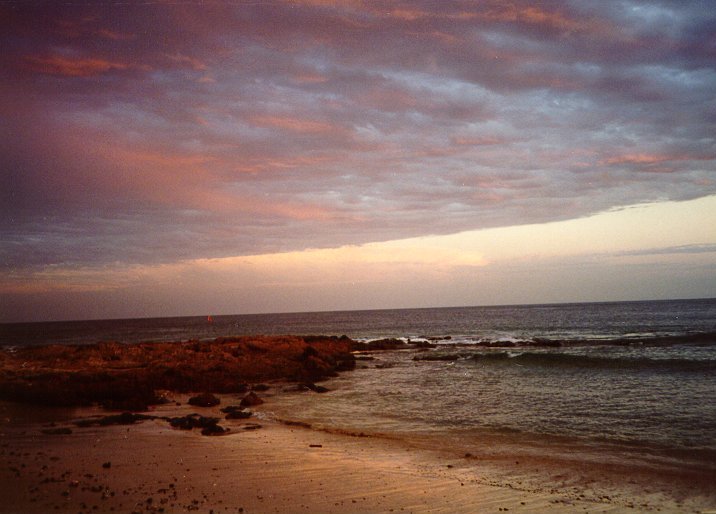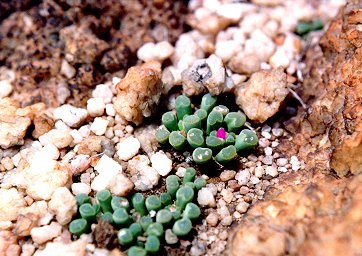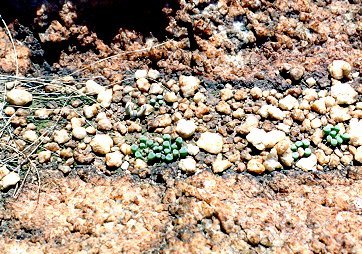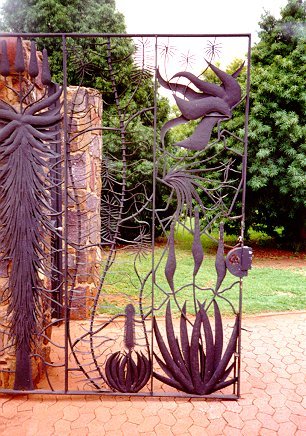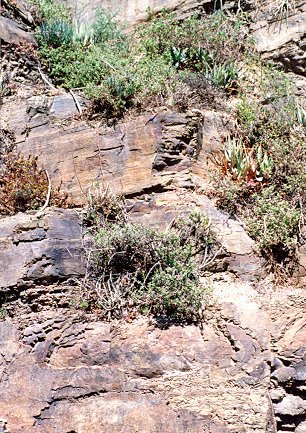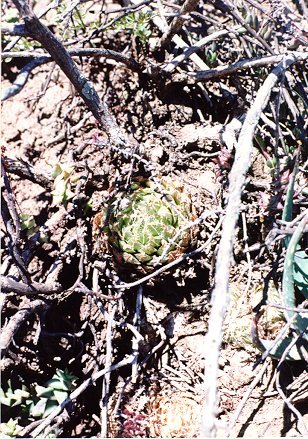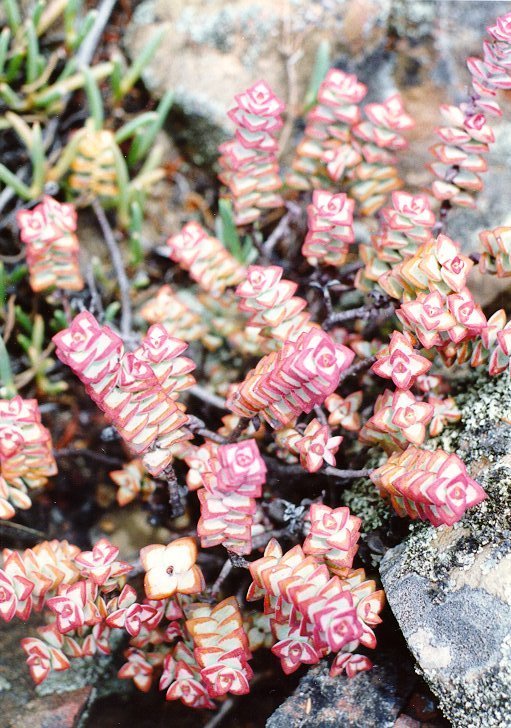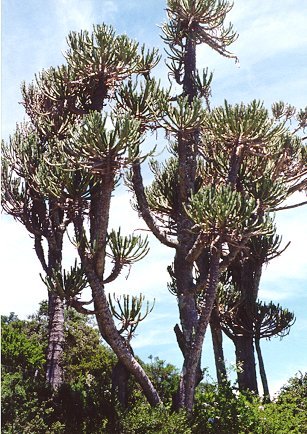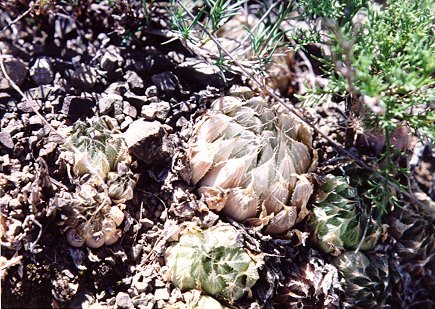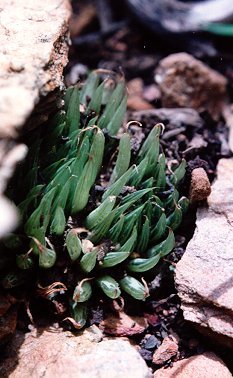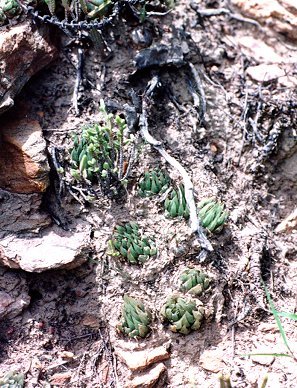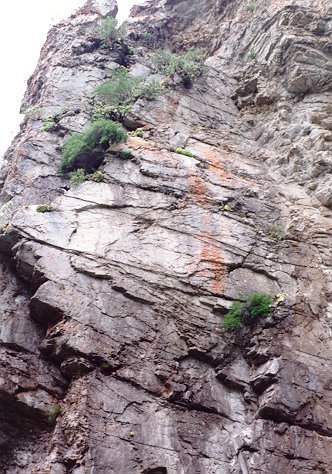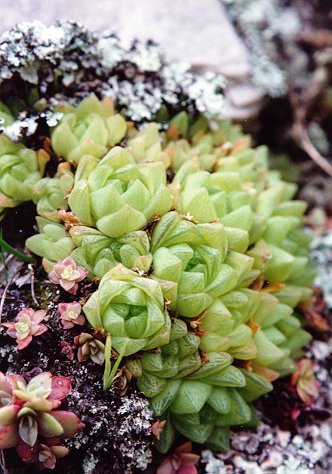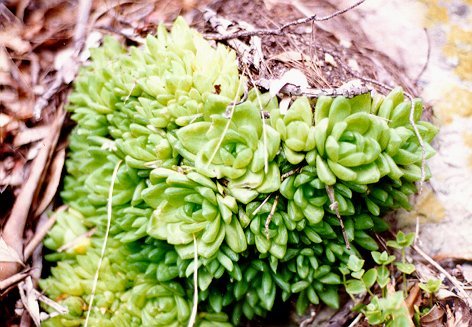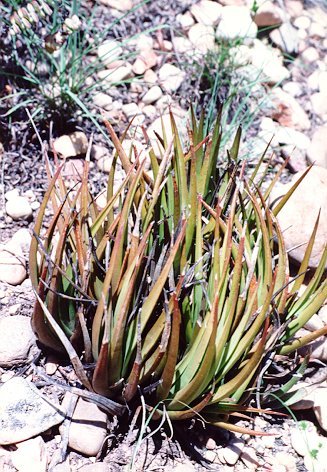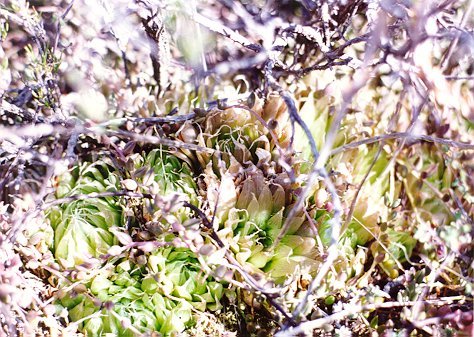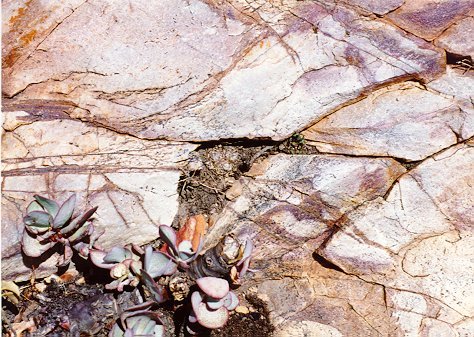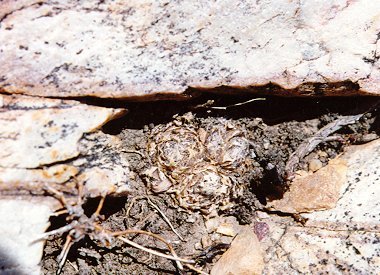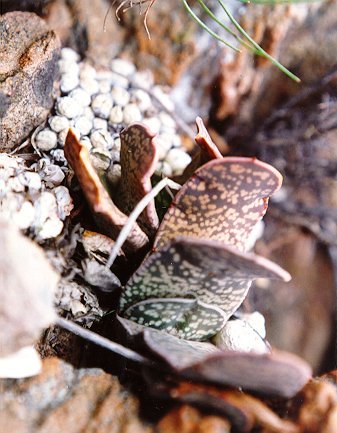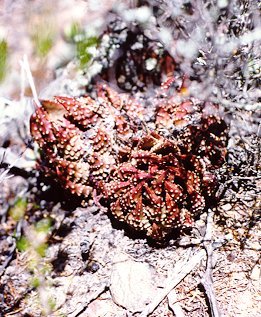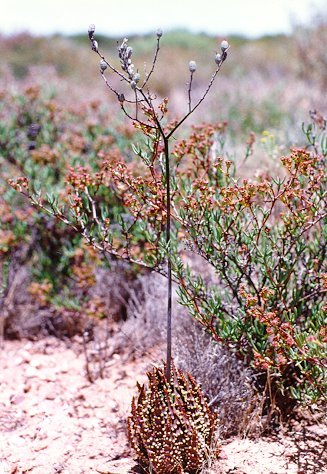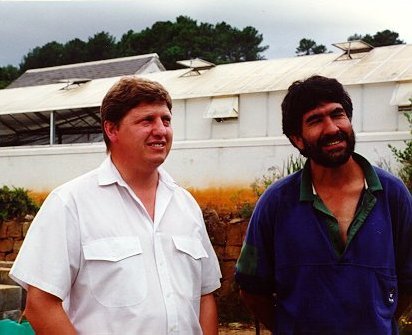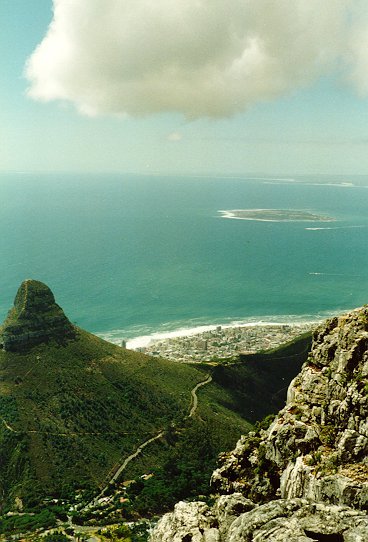At first my business trip to South Africa was a dream, a wish, then on, then off, then back on, then delayed, and finally after years of daydreaming and scheming I found myself half a world away. I left work just before noon on Friday January 14 and took a short flight from Bradley International Airport near Hartford Connecticut to JFK International Airport in New York. A few hours later I boarded a South African Airways flight to Johannesburg South Africa. The flight was a direct nonstop to Jan Smuts International. I was expecting the 14 hour flight to be stiff, cramped, boring and painful. However, a little South African wine and a good meal put me at ease and even with the delays in taking off and the hectic airport routines I was soon mellow enough to sleep for seven or so hours. Shortly after waking I remember looking out the window onto what must have been the northern coast of Namibia; barren, colorful rocks and sands, not a road to be seen. A good place to get lost in. A couple hours later I landed in South Africa a little after 4:30 p.m. on Saturday. Michele, my host, picked me up and took me to my hotel and anxious to see South African we went for a drive through the northern suburbs of Johannesburg. Later her husband joined us at a restaurant for a fine South African dinner, a nice way to start off the trip. On Sunday Michele, her husband John, and daughter Pascale took me for a drive west of Johannesburg along the Magaliesberg mountain range to visit the Rustenburg Nature Reserve. We arrived at the visitor center at mid morning after stopping a time or two to along the way to look at the zebra, hartebeest, eland, sable, and springbok. We went on a 5 or 6 km hike. I had wanted to try and find Frithia pulchra and Aloe peglarae which were reported to be there. As it turned out the peglarae were few in number and difficult to find. The baby toes were impossible to find at the spot indicated on the map, luckily a few hundred meters further along the trail, in quartz veins and pans were hundreds of these bizarre mesembs in flower. It was spectacular to see these little plants popping out all over.
Luckily it had rained within days of my visit; there was standing water in the hollows of some rocks. My hosts were very interested in what I told them about the plants I saw along the way. Michele summed it up; “I can’t believe we’ve learned about these plants from a Yank.” Imagine being in your favorite park with a foreign visitor and having your flora pointed out to you for the first time. My (limited) knowledge of their geography, geology, and botany blew them away. On the drive back to Johannesburg we got caught in a spectacularly heavy thunderstorm, a daily event, I’m told, in the summer months. The day wasn’t all plants; we talked of work and South Africa and life and literature and science and statistics and rock & roll. What a wonderful way to make a new friend, and a great introduction to South Africa.
One day after finishing work in the plant I went for a drive east of the plant through Middleburg, past the Loskop Dam to Groblersdal, and then back to Bronkhorstspruit. I didn’t know where to go to see Haworthia koelmaniorum or Haworthia mcmurtryi. Had I realized before my trip that the manufacturing plant was within an hour of the Loskop Dam I would have made sure to have gotten directions for seeing these two rarities. Oh well, something to do on my next trip!
On Saturday morning I spent a few hours at the Pretoria Botanical Gardens. The gardens were very lovely. I couldn’t find anyone at the Herbarium, oh well. The gate to the gardens caught my attention; ironwork aloes.
South Africa is certainly a land of contrasts, it was everything I had expected and then not quite what I thought it would be. The white communities were more affluent than I had expected. The roadways were in very good condition. The suburbs were first world. At times I could have sworn that I was in California, or Virginia. I saw Kentucky Fried Chicken, Midas Muffler, Hertz, Toys-R-Us, Woolworths, ATM’s, cellular phones, BMW’s, hamburgers, pizza, Hard Rock Cafes, shopping malls, mall rats, punks, beach babes, traffic jams, speed traps. I felt right at home; almost.
The townships were much as I had expected; sad, sad, sad. I can’t describe how depressed shanty towns made me. My throat chokes up when I try to talk about it. My throat hurts now and I’m just trying to type and its days after being away. Maybe in time the new government will make change here. Maybe the tax increases on the whites will be gradual and sufficient. Maybe the economy will grow and population growth will slow and the children will teach their parents and the children will retain their parents reserve and the whites will share and the blacks and coloreds will have even more patience. Maybe things will work out. But still I am sad. Oh how I pray for peace.
Following a week of business I took nine days personal time and on my own drove from Pretoria to Bloemfontein then Port Elizabeth and on to Cape Town. This part of my journey is what I’ve dreamed about for years. I was scared to death about racial violence. I was worried about getting lost. Here I was on my own and half a world away, and on the wrong side of the road! My original plans were to spend a week and a half at work and a week and a half or two exploring the Cape. My trip start got pushed back and my trip end didn’t. I wish I had had another week or two to spend. I was going to drive from Johannesburg to Grahamstown and then on to Cape Town. The folks at Ensign-Bickford all were in agreement that the drive would be boring, uninteresting, monotonous, and long. I then decided to fly to Port Elizabeth and then rent a car. So I made arrangements for a flight and a car rental. When I got to the airport and found the travel agent to pick up my tickets I was in for a big surprise. What tickets? No one had a clue! I missed my flight. The next available flight was over 24 hours later. Screw it, I rented a car. I wanted to drive to Cape Town anyway! And I’m glad I did.
Starting from Jan Smuts Airport mid afternoon I made it to Bloemfontein by nightfall. The drive was anything but boring! The Orange Free State is flat but not without feature. The farms were interesting. The farms were arranged like those I’ve seen in Oklahoma, rectangles and straight line. The vistas were immense. That night I stayed at a Holiday Inn. Next door was Bloemfontein Hard Rock Cafe. I went in after settling into the hotel. It looked just like every other HRC except a little smaller. Here was pure American Rock and Roll, good old capitalism and Madison Avenue. I sampled a few African beers and struck up a conversation with a table of black students from the nearby university. The Cafe was an interesting microcosm. At one table a bunch of white jocks, at another a two couples, at another a mix of races, at another six tall black men. Soccer and rugby are very popular sports. I don’t know anything about American sports (don’t watch much TV), so I had to fake it. The black guys were all very curious about particular personalities, and the baseball strike, and the reasons why. Anyway the next morning I went off to Port Elizabeth.
South of Bloemfontein toward Colesberg I saw Aloe broomii on hills south of the Orange River. Then continuing to Colesberg I saw Aloe broomii again on ridges just before Nouport on the right side of the road. I continued south on R57/R32 to Middelburg and on toward Cradock on R32. Now I got out my topographical maps. 3224 Graaff Reinet map to be specific. I continued south from Middleburg to Cradock. Just below an irrigation canal, where the ridge and road and river come together on the right side of the road, I found my first Haworthia.This was quite an emotional experience for me. I wasn’t sure what to look for. I didn’t expect plants in plastic or red clay pots in nice straight rows. I didn’t expect color photographic-macro lens close-up color photographs. Still I wasn’t sure what to look for. I wasn’t sure if I needed to get on my hands and knees or whether I needed to search far and wide. As it turned out I parked the car and walked up and down the road getting my bearings and without even trying I saw a clump of Haworthia peeking out from under a scrub brush, and up the small bank I went. The hillside here was a perfect succulent rock garden. There were so many interesting plants I had all I could do to keep my eyes on the Haworthia clumps. So there I was looking at my first real Haworthia. I sat down and took a deep breath and I looked and listened and thought and waited, the wind blowing, music coming over on the wind from the nearby village. After a while I crawled around looking at the soil, the crassula, the brush, the sky, I closed my eyes again and listened to the wind, the singing from across the river. This was what my years of daydreams and wishes and plans had all lead up to. I was very content, very happy. If I didn’t see another Haworthia for the rest of the trip all I had been through would have been worth it just to spend that time on the hillside with Haworthia blackbeardiana. This was a day I’ll never forget.
A succulent garden (can you see the Haworthia?), Haworthia blackbeardiana, Crassula.
From there I return to Cradock and continued south. West of Cradock is the Mountain Zebra National Park on R61. I had seen a few zebra at Rustenburg. Here I saw many more and I think the zebra here were different, maybe their stripe pattern, maybe their size. Anyway, this park was inexpensive and worth the detour and partially made up a little bit for not going to Kruger Park.
From R32 I took the Bedford turnoff, and on through Bedford to Adelaide. Just past Adelaide (on the way to Grahamstown),I took R344, a dirt road, east of town south to Grahamstown. Unexpectedly I drove through a ‘forest’ of tall Euphorbia trees. These ‘trees’ were impressive. I had no idea that such tall sentinels existed in this part South Africa. At a bridge over the Koonapriver I parked and went to look at a shale bank along the side of the road. On the weathering shale bank I found Haworthia cooperi, one of my favorite Haworthias. While sitting along side of the road a beat up old pick up truck pulled up, the first vehicle I had seen in hours. The old farmer said some words. I spoke back in English. He asked in English if I needed help and one thing led to another and he stopped his engine and we talked. He hadn’t seen any ‘plant people’ here in a while. He wanted to know what was so special with these plants. Where could I possibly begin. I showed him my copy of Bayer’s Handbook. He got out of the truck, parked in the middle of the dirt road. Never mind, there hadn’t been anyone along this road in several hours. He climbed up the bank with me. He called his ‘Blacks’ to come up with him. I showed him the plants. He spoke to the African in Afrikaans. They asked me questions, the farmer translating, again in his broken and thick English. We talked about the soil and the local geology and farming and biology and a little about his life and mine. Damn, such nice people. Next thing I knew he was on his way into town and although he had offered to take me back to his farm on his way home, but I had to move on. I declined his offer but took his address and maybe on my next trip I’ll arrange to spend a few days with him.
Euphorbia trees, Haworthia cooperi.
After what felt like days but was only hours I finally came to a paved road (R350) and headed NW toward Aylesbury. At a pass on north facing slopes I saw Aloe ferox, Aloe speciosa, and when I stopped and poked around I found Haworthia transluscens on the bank growing in crevices. This form was longer and more transluscent that any plant in my collection. I wonder whether genes or environment account for this. Time will tell. I turned back to Grahamstown and went into town. I had wanted to visit Gerhard Marx, but he was away with my Cape Town friend Kobus at Riversdale. Grahamstown is a lovely community, shady tree line streets, old buildings, flowers, ladies in white hats, polite storekeepers. I hope to get back there sometime. In town there is a great historical society, well worth the few cents admission. The town has a long history. The rivalry between the English and the Dutch (Boers) came to head in places like Grahamstown and Graaff Reinet.
Haworthia transluscens, a clump emerging out of the mud.
I continued on and took N2 east and at R67 I took a left to Fort Beaufort. At top of ridge I found A. G. Bain Memorial. Here I found, south of the memorial, Haworthia corcacta adelensis, Gasteria bicolor, Euphorbia meloformis, Aloe squarosa, Aloe africana, Faucaria britani, Strelitzia (crane flowers), and two different kinds of tortoise. From the Memorial I continue on and drove down to Plutosvale. At the bottom of the valley the road crosses a stream several times. I walked up and down and up and down and couldn’t find Haworthia tenera. Perhaps I was in the wrong place, more than likely I didn’t know what to look for. After giving up I went back up the valley to N2 and went further east to Fraser’s Camp near the Fish River where I stopped at an old small fort on the side of the road. Behind the fort I stopped and asked the farmer’s wife if I could look at the plants. She laughed and said something and pointed the way. On the hill just near the fort I saw Haworthia reinwardtii bevicula. These plants grew in good size clumps and were very handsome.
I turned around and headed back west to Grahamstown and went on to Port Elizabeth. I arrived in town just before sundown and even before checking into a room I went for a swim in the Indian Ocean. Clear blue water, a little warmer than I had expected, refreshing nonetheless. It was a great thrill being in warm water while at home in New England it was the middle of winter. From the looks of the board walk and the residential areas PE is a wonderful city.
The next morning I went to Settlers Park located in the middle of the city, west of the business district. I went for a walk along the Bakens River. Cliffs line both sides of the river. On the rock faces I found Haworthia cymbiformis and fasciata. A family came walking along while I was hanging off a ledge halfway up the cliff, maybe a 150 feet up, the wife shouted up to me, with a note of concern, ‘What are you doing?’ I held up my camera and pointed at the plants, they laughed(crazy person) and went on their way. This Haworthia site was possibly the oddest of the whole trip, surrounded on all sides by a big city. From Port Elizabeth I took the “Old Cape Road” west and went toward Bethelsdorp. Just before reaching town, in a valley with ridges on both sides I stopped and walked up the hill and saw hundreds of Haworthia fasciata, trailing Aloe tenuior, Pachypodium bispirosa.
Haworthia longiana.
Bright and early the next morning I went to a hill south of town to an old fort and searched for almost three hours in vain for Haworthia uniondalensis. I must be blind. Just north of town in a pass at a sharp turn west I searched along several outcrops and found tiny Haworthia divergens growing in crevices. From Uniondale I went to De Rust and headed north into the Meiringspoort. The scenery was exceptional. I went for a hike into a kloof to a wonderful waterfall. This valley was impressive. I could have stayed longer but something kept pulling me west. I continued on to Dysselsdorp and Oudtshoorn. At the middle of town I went north toward Prince Albert and to the Kango Caves. Just past the last farmhouses north of Oudtshoorn I stopped and looked at the rock faces and on rocks along the side of the road. I saw great clumps of Haworthia starkyiana. The plants varied in size, color, and twist. Leaves varied from 1 inch to 6 , colors yellow to red, some twist clockwise others counter. Schoemanspoort was, like Meiringspoort, a beautiful place. The rocks thrown up in bands with colors and shadows, a water fall here, a troop of baboons there, succulents allover. What a wonderful place. Great geology too. From Oudtshoorn I took an unplanned detour south to Mossel Bay and took another swim in the ocean. I am torn between my loves of the sea and the mountains. I will swim any chance I can get. The sound of waves crashing soothes my soul. The rustle of the wind in the mountains when on a long hike calms my mind. This was a great day; sea and succulents. Late in the afternoon I raced west on N2 to Riversdale for the night.
From Montagu I continued west to Ashton to Robertson and made a quick stop at Sheilam Nursery. I spent less than an hour there because I had my mind set on spending some time at the Karoo Botanical Garden. A few kilometers past Robertson at a ridge crossing the road I parked, there 50 to 70 meters up the rise I found Haworthia magnifica var. marasii (only a few plants), Conophytum ficiformi in great numbers, Aloe microstygma, and Gasteria disticha.
Gasteria disticha, Haworthia pumila.
Once in Worcester I stopped and walked around the town center, a lovely town surrounded by mountains. The botanical gardens were very interesting, better yet was the three-hour hike I took. Here I saw Haworthia pumila and herbacea. The herbacea was growing with Conophytum in shale crevices and under scrub brush.
From Worcester I went to find my friend Kobus. I arrived at Kobus’ late in the afternoon of Thursday January 26. After settling in he and I went into Cape Town and climbed Lion Head and watched the sun set. While climbing Kobus was pleased to see a Tylecodon in flower.
On Friday Kobus and I went on a hike with Bruce and Daphne Bayer. We climbed Rooiberg, a good sized mountain located between Worcester and Robertson, we were looking for a “new” Haworthia species found by Peter Bruyns. We spent half a day in vain but did see Haworthia magnifica var. maraisii, a tiny form of H. pumila,and H. reticulata. In the afternoon we stopped in at Shielam where a tall glass of cold water made my day. It was very interesting being with Kobus and Bruce as they went through the greenhouses. We then went on to the Karoo Botanical Gardens where Bruce gave us a tour of the Haworthia reference collection. He spent a bit of time searching through the documentation archives. Bruce may be contemplating a new Haworthia book (three cheers!). After stopping at Sheilam and Karoo Botanical we dropped the Bayers off in Paarl. Then Kobus and I went back to his home. It was well past dark by the time we got back to Bellville. Kobus, Mirna, and I went out to dinner to Tijgerkombuis, an Afrikaans restaurant, where I had a great sample of traditional food, a wonderful evening with a wonderful couple.
On Saturday we went to Caledon where we saw Haworthia mirabilis. In Napier I saw H. magnifica, and in Bredasdorp we came upon H. mundala and H. minima, in Bonnievale maraisii and reticulata hurlingii, and Worcester a giant form of pumila (literally the size of footballs). Somewhere along the way we stopped at a stream to find Gasteria carinata. As we were leaving a bakkie (Afrikaans for pickup truck) approached with a man and two of his children. Kobus explained what we were up to and made apologies. The farmer didn’t know what he had. The farmer wanted to see what we were looking at. He had never noticed the Gasteria before. He thought we were a little odd but harmless and smiled and waved as we went on our way. What a great day with 10 Haworthia sites visited.
Kobus Venter and Ernst van Jaarsveld, Cape Town from the top of Table Mountain.
On Sunday we went to Kirstenbosch to visit Ernst van Jaarsveld and the Gasteria reference collection. We then went for a drive around Table Mountain and took the cable car to the top and all too soon ran out of time.
Some day I’ll go back to South Africa. It is such a wonderful country, I can’t wait to return!

